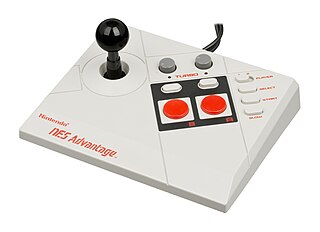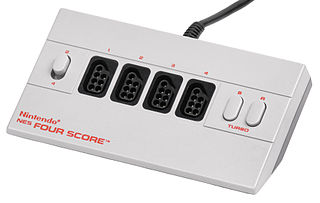
The NES Advantage is an arcade style controller manufactured by Asciiware and released by Nintendo for the Nintendo Entertainment System in 1987. The device is meant to rest on a flat surface at a comfortable level, such as a tabletop or the floor, with the player seated behind it. This way, it can be used like an arcade game joystick—with the left hand using the joystick and the right hand operating the buttons.

The Zapper is an electronic light gun accessory launched within the Nintendo Entertainment System (NES) in North America on October 18, 1985. It is a cosmetic redesign by Nintendo of America's head designer Lance Barr, based on Gunpei Yokoi's Video Shooting Series light gun (光線銃シリーズガン), which had been released in Japan for the Famicom on February 18, 1984. The Zapper requires compatible NES games, such as Duck Hunt, Wild Gunman, and Hogan's Alley. Its internal optical sensor allows the player to aim at a television set and accurately shoot at in-game targets.

The Super Game Boy is a peripheral that allows Game Boy cartridges to be played on a Super Nintendo Entertainment System console. Released in June 1994, it retailed for US$59.99 in the United States and £49.99 in the United Kingdom. In South Korea, it is called the Super Mini Comboy and was distributed by Hyundai Electronics. A revised model, the Super Game Boy 2, was released in Japan in January 1998.

The Game Boy Player is a GameCube peripheral developed by Nintendo which enables it to play Game Boy, Game Boy Color, and Game Boy Advance cartridges, allowing those games to be played on a television.

The NES Four Score is a multitap accessory created by Nintendo in 1990 for the Nintendo Entertainment System. Select games can utilize it to enable up to four-player gameplay. The NES Four Score is similar to the previously introduced NES Satellite, a device that allows four players to connect to the NES and extends the range using infrared wireless communication.

The WaveBird Wireless Controller is a radio frequency-based wireless controller manufactured by Nintendo for use with the GameCube home video game console. Its name is a reference to Dolphin, the GameCube's codename during development. The WaveBird was available for purchase separately as well as in bundles with either Metroid Prime or Mario Party 4, which were exclusive to Kmart in the US.
A multitap is a video game console peripheral that increases the number of controller ports available to the player, allowing additional controllers to be plugged in simultaneously in a manner similar to a power strip or a USB hub. A multitap often takes the form of a box with three or more controller ports which is then connected to a controller port on the console itself.
The Atari 2700 is a prototype home video game console that was developed by Atari, Inc. to be a wirelessly controlled version of Atari's popular Atari 2600 system. Intended for release in 1981, the 2700 was one of several planned follow-ups to the 2600, but the system was never put into full production. While It is unclear how many of these systems exist, former Atari employee Dan Kramer has stated that at least 12 consoles were made, plus extra controllers.

Super Bomberman is an action, maze game, part of the Bomberman series, released for the Super NES in 1993. It is the first in the series to be released in Europe keeping the Bomberman title instead of being called Dynablaster or Eric and the Floaters.
Various accessories for the PlayStation 3 video game console have been produced by Sony and third-party companies. These include controllers, audio and video input devices like microphones, video cameras, and cables for better sound and picture quality.
This is a list of video game accessories that have been released for the Game Boy handheld console and its successors. Accessories add functionality that the console would otherwise not have.

Micro Genius is a brand name used for Famicom clone consoles marketed in several countries around the world, particularly in areas where Nintendo consoles were not readily available, including the Middle East, Southeast Asia, South America, Eastern Europe, South Africa and East Asian countries excluding Japan and South Korea. The name was initially and most famously used by TXC Corporation for its range of Taiwanese-made Famicom clones, software and accessories, but later passed to other companies and remains in use today on rebranded Chinese Famicom clones and LCD games.
Nintendo 64 accessories are first-party Nintendo hardware—and third-party hardware, licensed and unlicensed. Nintendo's first-party accessories are mainly transformative system expansions: the 64DD Internet multimedia platform, with a floppy drive, video capture and editor, game building setup, web browser, and online service; the controller plus its own expansions for storage and rumble feedback; and the RAM-boosting Expansion Pak for big improvements in graphics and gameplay. Third-party accessories include the essential game developer tools built by SGI and SN Systems on Nintendo's behalf, an unlicensed SharkWire online service, and unlicensed cheaper counterparts to first-party items. In the fifth generation of video game consoles, the Nintendo 64 had a market lifespan from 1996 to 2002.
GameCube accessories include first-party releases from Nintendo, and third-party devices, since the GameCube's launch in 2001.
Various accessories for the PlayStation 2 video game console have been produced by Sony, as well as third parties. These include controllers, audio and video input devices such as microphones and video cameras, and cables for better sound and picture quality.

The Acclaim Remote Controller is a third party wireless game controller developed by Acclaim Entertainment Inc for the Nintendo Entertainment System (NES) in 1989. This accessory used standard IR signals, commonly found in other remote controls of the time, to send button inputs from the wireless control pad to a receiver plugged into a controller port on the console.









